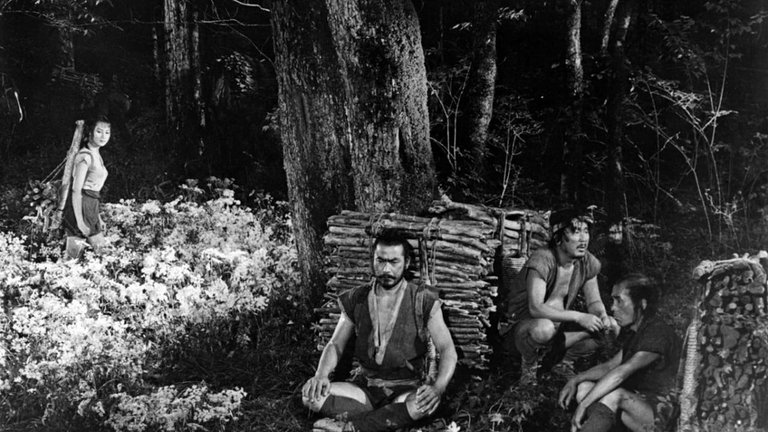
In 1980, Akira Kurosawa, a Japanese director and one of the giants of 20th Century cinema, had his career revived with Kagemusha, a jidai geki spectacle made possible, among other things, with the aid of George Lucas. The American filmmaker felt a strong sense of obligation towards his Japanese colleague, as his own magnum opus, the 1977 science fiction epic Star Wars, had been heavily inspired by Kurosawa's jidai geki films, with 1958's The Hidden Fortress being a primary influence. The similarities between these two films are so numerous and glaringly obvious that one can hardly consider Star Wars anything other than a remake of The Hidden Fortress.
Set in 16th Century Japan, during the Sengoku period of endemic warfare between rival feudal clans, the narrative centres around Tahei (played by Minoru Chiaki) and Matashichi (played by Kamatari Fujiwara), two destitute peasants who attempt to forge a new life as soldiers during the conflict between the Yamane and Akizuki clans. Their efforts prove fruitless, leading to hunger, deprivation, and ultimately being captured by the Yamane, who mistakenly believe them to be soldiers of the defeated Akizuki clan. Escaping their captors, Tahei and Matashichi inadvertently stumble upon a cache of gold that apparently belonged to the Akizuki clan. Along their journey, they encounter a mysterious bandit (played by Toshiro Mifune) and a 16-year-old mute girl (played by Misa Uehara). It is later revealed that the bandit is, in fact, Rokurota Makabe, a renowned samurai and general in Akizuki service, and that the girl is Yuki, the princess of the Akizuki clan. Makabe's plan is to escort the princess and the gold across the border of the neutral Hayakawa clan. They are pursued relentlessly by Yamane troops, which include the formidable Hyoe Tadokoro (played by Susumu Fujita), a renowned general and Makabe's friend.
At first glance, inevitable comparisons between Kurosawa's and Lucas' film give a clear advantage to the latter, due to being made in colour and having a much higher budget. Star Wars provides the audience with better visuals and spectacle. For the standards of late 1950s Japanese cinema, however, The Hidden Fortress was quite remarkable, with black-and-white cinematography by Ichio Yamazaki much enhanced with Tohoscope widescreen format. This allowed Kurosawa to fill the film with memorable images, often putting locations of Japanese mountains and forests to excellent use.
However, modern audiences, at least those familiar with Star Wars, would be much more impressed with the way Kurosawa has created a template for Lucas, especially in terms of plot and characters. Tahei and Matashichi, two bickering peasants who are introduced at the beginning at the scorched landscape, look very much like C-3PO and R2-D2 on Tatooine. Wise noble warrior Makabe serves as the model for Obi-Wan Kenobi, while the independent-minded princess Yuki is the spiritual predecessor of Leia Organa. Akizuki could easily stand for the Rebel Alliance, just as Yamane can stand for the Galactic Empire, with General Tadokoro being this film's equivalent of Darth Vader.
The similarities don't stop there, and they could be observed even in terms of visuals, shot composition (most obvious at the film's ending), and even wipes transition between shots. It would be unfair to reduce The Hidden Fortress to merely a template for Star Wars; it is an interesting film in its own right, and in many ways different from Lucas' science fiction epic. Kurosawa used the medium of period adventure film to explore some of his favourite themes and express some of his views on the universal human condition, as well as his nation's past and present.
What makes The Hidden Fortress interesting is Kurosawa's depiction of feudal Japan as not inherently violent, but an unjust and cruel society that dehumanises not only those on the top, but also those on the bottom. Tahei and Matashichi, the nominal protagonists, are portrayed not only as victims of poverty, oppression, and violence, but also corrupted by the very same evils they experienced. For most of the film, they are motivated by greed and the basest instincts, including a scene in which, not knowing Yuki's true identity, they discuss whether they should have their way with the attractive 16-year-old girl. Thanks to the excellent acting talents of Chiaki and Fujiwara, the audience will accept those flawed characters as they are and even win some of their sympathies, especially near the end when they finally see the error of their ways.
Toshiro Mifune, who plays the regal and noble character, a conventional hero, is, on the other hand, easily outshone by Misa Uehara, a young actress whose career was short. She plays Yuki as the true moral anchor of the film, a princess who was forced to leave her pampered aristocratic life and try to survive as a commoner on the road. This experience changes Yuki, making her more sympathetic towards her social inferiors and explicitly expressing Kurosawa's humanistic views while implicitly doing so by enthusiastically taking part in a commoners' village festival.
The Hidden Fortress was a box office success in Japan and won many admirers among foreign critics, although some complained over poor pacing, which is, to a certain degree, a complaint that holds some validity even now. In 2008, The Hidden Fortress received its direct Japanese remake as Hidden Fortress: The Last Princes, a film directed by Shinji Higuchi.
Despite its age and some flaws, The Hidden Fortress is a very good film that could be enjoyed and appreciated on its own merit, regardless of whether someone is a Star Wars fan or not.
RATING: 8/10 (+++)
Blog in Croatian https://draxblog.com
Blog in English https://draxreview.wordpress.com/
InLeo blog https://inleo.io/@drax.leo
Hiveonboard: https://hiveonboard.com?ref=drax
Rising Star game: https://www.risingstargame.com?referrer=drax
1Inch: https://1inch.exchange/#/r/0x83823d8CCB74F828148258BB4457642124b1328e
BTC donations: 1EWxiMiP6iiG9rger3NuUSd6HByaxQWafG
ETH donations: 0xB305F144323b99e6f8b1d66f5D7DE78B498C32A7
BCH donations: qpvxw0jax79lhmvlgcldkzpqanf03r9cjv8y6gtmk9
Posted Using InLeo Alpha